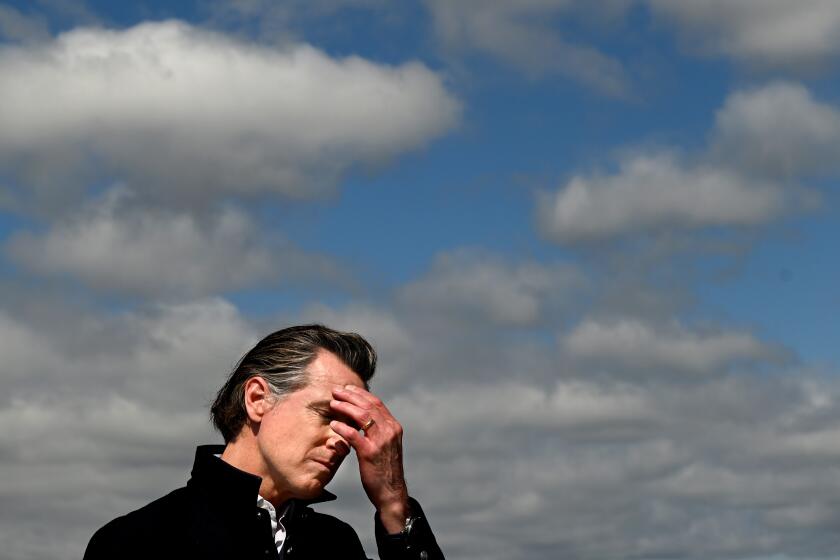COLUMN ONE : THE MALTA SUMMIT : Keeping a Lid on Gorbachev : Bush’s image-makers are scrambling to play to his strengths at the Malta summit. Their script gives new meaning to the notion of Soviet containment.
- Share via
WASHINGTON — Nearly every major event has a defining symbol. The leading candidate to play that role in this weekend’s Malta summit meeting between George Bush and Mikhail S. Gorbachev is a helicopter.
This particular helicopter will belong to the U.S. Navy. On board will be a small group of reporters and a large group of television cameras. The chopper will hover in the space over Marsaxlokk Bay as Bush shuttles between the Belknap, the Navy cruiser that will host U.S. events at the summit, and the Slava, its Soviet counterpart. Photos will be encouraged. Questions and answers will be impossible.
That is precisely the intention. Ships at sea, men in flight jackets, leaders waging peace--these are the images the White House wants Americans to see.
But more important for the public relations strategy of Bush’s chief of staff, John H. Sununu, and his chief image consultant, former campaign advertising wizard Sig Rogich, are the images they want to avoid.
Chief among these is that of dynamic Soviet leadership contrasted with American “prudent caution.” And so the details of the summit have been designed in large part to level the playing field for Bush.
The leaders will be seen relatively little and heard even less. Gorbachev, who commandeeredtelevision news broadcasts two years ago by jumping out of his limousine during the Washington summit and pressing the flesh, will have few such opportunities this time.
White House officials, planning jointly with the Soviet and Maltese governments, worked out the details of summit press coverage. But glasnost (Gorbachev’s policy of openness) notwithstanding, Americans still have far more experience in media management than do their Soviet counterparts.
Moreover, because the Americans extended the initial invitation for the summit, protocol dictated that “they get to propose the setting,” said Lane Venardos, a veteran CBS News director who has been involved in negotiating with the White House over the summit.
Gorbachev could still try to perform the sort of spontaneous camera-attracting moves he showed during previous visits to Washington and New York, Venardos noted. But doing so “would mean clearly going outside the rules.”
The helicopter, hovering within camera range but out of earshot, is the clearest example of how those rules will work. But there are many others.
All meetings between the two leaders will take place aboard ship, where press coverage will be tightly controlled and strictly limited. Particularly difficult will be pictures of the two leaders together, when Gorbachev might be expected to steal the show.
Both leaders will spend their off-hours on the water as well. But the press lost its battle to keep a pool of reporters and cameras on board the ship in case the leaders want to stroll the decks.
The two leaders will also dine together, but the White House has decided that the press will not be allowed to visit or photograph the meals, much less ask any questions. There are no plans for either Bush or Gorbachev to venture onto the Maltese islands, except upon arrival and departure.
And although both sides plan to have large contingents of officials on hand to speak with inquiring reporters, those officials will know little, if anything, about what is actually going on in the shipboard meetings.
The official White House position, in the words of White House Press Secretary Marlin Fitzwater, is that Bush wanted “to minimize the need for these symbolic pictures and rather focus on the conversation, the words and the substance.”
“The pictures are too simplified a message,” Fitzwater said. “Frankly, I am not sure you are going to get too many great pictures.”
The President is “looking to underdramatize by underplaying for the cameras,” said another senior White House official.
That, however, is only part of the story.
Although George Bush’s White House is not as image-centered as was Ronald Reagan’s, Bush did not win the 1988 election by ignoring the importance of image. He and his campaign chairman, James A. Baker III, who is now his secretary of state, presided over a strategy that heavily emphasized such symbols as the American flag to project an image of strength.
Bush’s team knows that the President performs best in informal, personal settings, in contrast to Gorbachev’s ability to command a public stage. Putting the meetings on ships “produces a forum that President Bush is comfortable with,” Fitzwater said.
ABC correspondent Brit Hume said of Bush: “His continuing wariness of Gorbachev . . . permeates the high command. . . . I don’t think there is any question” that keeping a lid on Gorbachev is more important to the White House team than any affirmative images Bush might want to project.
On the summit’s eve, polls show that the public has a strong sense Bush is responding to events rather than directing them. Because the news from overseas has been overwhelmingly good, the lack of bold leadership has not bothered most Americans.
A recent Los Angeles Times poll asked respondents if they thought Bush had “a clear blueprint for the future” or was “mostly trying to catch up with recent developments.” Fully two-thirds of the respondents said he was following events, not leading them. Only 17% said Bush had a “clear blueprint.”
At the same time, the survey participants overwhelmingly rejected the view that Bush was being “too cautious” in responding to Gorbachev. Of those polled, 45% said that Bush was appropriately “somewhere in between” caution and boldness, and another 35% said he was “properly” cautious.
Those generally favorable numbers reinforce the dominant view among Bush’s advisers that the public does not want bold new adventures in either foreign or domestic policy and will be willing to reward Bush with another term so long as nothing goes seriously awry during his tenure.
“Bush is in a position where it’s not necessary for him to embrace” bold initiatives, said longtime adviser Pete Teeley. “He’s got the luxury of sitting back” and waiting to see how events develop.
Fitzwater called Bush’s position “incredibly strong” as he goes into the Malta summit. “He doesn’t need to be producing any kinds of dramatic events or pictures to demonstrate his leadership,” Fitzwater said. “It is there, it is solid, it is well understood by anybody who wants to study the situation.”
Privately, by contrast, Bush advisers concede that the President has not put his own stamp on events. Politically, that means Bush has little opportunity to win much credit for the upheaval in Eastern Europe that seems to be bringing the Cold War to an end.
In the pre-summit buildup, Bush has seemed to have difficulty clearly conveying his ideas about the dramatic changes in Eastern Europe. Most notably, he was widely criticized earlier this month for appearing pensive and almost downcast about East Germany’s decision to open the Berlin Wall--a sharp contrast to the joyful scenes of Germans dancing on what had been the starkest symbol of the Cold War.
Bush’s aides spent most of the rest of the week creating openings in speeches and photo opportunities for the President to try to erase that downbeat image. Bush’s prime-time televised address to the nation last week, only his second as President, was designed in part to achieve the same goal.
The summit could provide an even better opportunity for Bush to get his ideas across. But the President has seemed to approach the summit defensively, trying to avert potential problems instead of setting up diplomatic triumphs.
In an Oval Office press conference Tuesday, for instance, Bush seemed particularly attuned to the concern among Western allies that he would bargain away their future. He told reporters that he would agree to no proposals without checking with NATO allies first.
But if little of substance emerges from Malta, at least there will be pictures. Accordingly, one of Bush’s first moves upon arriving in Malta on Friday afternoon will be to take a helicopter of his own to the aircraft carrier Forrestal to watch a takeoff and landing exercise and to lunch with Navy fliers.
Thanks to the time difference between Malta and the United States--six hours ahead of the East Coast, nine ahead of the West Coast--Americans will wake up to the image of their President, a Navy flier himself in World War II, mixing with the troops before he begins negotiations with the Soviet leader. Because there are no other public events scheduled that day, that same image is likely to be repeated on evening news programs as well.
Over the next three days, as Bush first meets with Gorbachev and then travels to Brussels to brief North Atlantic Treaty Organization allies, Americans will see their President in the circumstances the White House likes best--not the emotion-charged settings that the Reagan White House preferred but rather scenes of men at work.
“We hope,” said Fitzwater, “the impression will be left that they had a very serious, working kind of meeting.”
More to Read
Sign up for Essential California
The most important California stories and recommendations in your inbox every morning.
You may occasionally receive promotional content from the Los Angeles Times.











